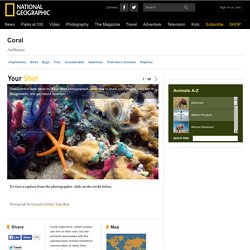

Sharks. The first sharks lived around 400 million years ago, with most sharks developing during the Cretaceous period - that's 64 million years ago.

Only 3 kinds of shark, the great white shark, the tiger shark and the bull shark, are involved in most attacks on humans. Physical description Sharks vary greatly in size and habit. Whale sharks are the largest of all fish and can grow up to 12m long and weigh up to 12,000kg. Sharks Endangered - Shark Facts and Information. Many types of sharks are at risk of becoming extinct which is why conservation efforts are in place.

Extreme hunting of them to protect the waters, to have more fish alive that could be used for commercial fishing catches, and for food sources have greatly depleted the number of them out there. Sharks and humans don’t have a good relationship, but through the compassion of some humans they may have a chance to survive. Endangered Species. Shark Facts and Information. Could Megalodon Still Live In The Deep Ocean? The megalodon shark (C. megalodon) is widely regarded as both the largest shark to have ever lived on Earth and one of the largest vertebrate predators in history.

Megalodons roamed the seas from around 28 million years ago until ~1.6 million years ago, when they were wiped out during the Pleistocene extinction. Megalodons were, as we know, freaking huge. Some of the teeth discovered from this whopping great predator have been over 17 centimeters (7 inches) in total height, but the majority are between 3 and 5 inches (still, massive). Reconstructions using jaws and other fossilized remains suggest that megalodons probably reached maximum lengths of up to 54 feet (16.5 meters), around 3 times larger than great whites (C. carcharias). They even make T-rex’s look like pansies in comparison.
Image credit: Matt Martyniuk, via Wikimedia Commons. As mentioned, megalodons went extinct an estimated 1.6 million years ago. First off, nobody has direct evidence to suggest that they do still exist. Shark cousins by Navya. Ecosystems + Human Uses. Thresher Sharks. A diver has captured rare footage of the unique hunting style of thresher sharks in tropical waters off the Philippines.

The film was shot near coral reefs that fringe the tiny Pescador Island where huge shoals of sardines draw sharks to the area. It shows how thresher sharks accelerate towards dense shoals of fish, then brake by throwing their pectoral fins forward, causing the back end of the fish to rise in the water. This positions the shark perfectly to unleash a devastating bullwhip with the tail that stuns and kills fish close by. The strikes were filmed by Klemens Gann, an underwater videographer and diving instructor, and analysed by marine biologists in the Philippines and the UK. The hunting strategy was seen in males and females of all ages. The scientists studied 25 attacks on shoals of sardines between June and October 2010. After each attack, the sharks swam round in a gentle arc and returned to the spot to snaffle the stunned and dead sardines. Corals, Coral Pictures, Coral Facts. Coral organisms, called polyps, can live on their own, but are primarily associated with the spectacularly diverse limestone communities, or reefs, they construct.

Coral polyps are tiny, soft-bodied organisms related to sea anemones and jellyfish. At their base is a hard, protective limestone skeleton called a calicle, which forms the structure of coral reefs. Reefs begin when a polyp attaches itself to a rock on the sea floor, then divides, or buds, into thousands of clones. The polyp calicles connect to one another, creating a colony that acts as a single organism. As colonies grow over hundreds and thousands of years, they join with other colonies and become reefs. Coral polyps are actually translucent animals. Corals live in tropical waters throughout the world, generally close to the surface where the sun's rays can reach the algae. Coral reefs teem with life, covering less than one percent of the ocean floor, but supporting about 25 percent of all marine creatures. Coral Reefs. All around the world, much of the world’s marine biodiversity face threats from activities and events such as Climate change causing global mass coral bleaching Coral bleaching results in white, dead-looking, coral (top image).

Healthy coral, by contrast, is very colorful and rich with marine life. (Images source: Wikipedia) The above-mentioned Status of Coral Reefs Around the World, 2004 also notes (p. 21) that “The major emerging threat to coral reefs in the last decade has been coral bleaching and mortality associated with global climate change.” As explained by Rob Painting on the popular Skeptical Science blog, bleaching can occur for a number of reasons such as.